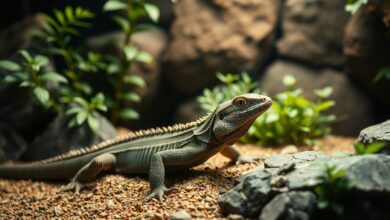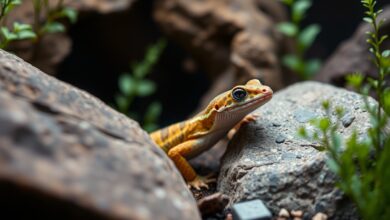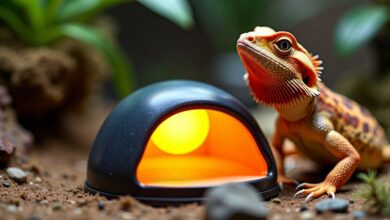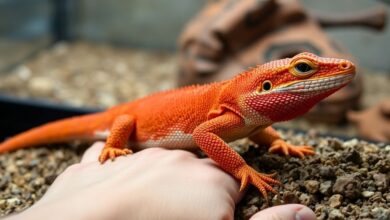Scaleless Corn Snake – 7 Care Tips and Health Considerations

Many reptile enthusiasts are drawn to the unique beauty and gentle temperament of the scaleless corn snake. As an owner, it’s crucial to understand the special care requirements that come with this striking morph. In this post, you’ll discover seven valuable tips to ensure your scaleless corn snake remains healthy and thriving. From habitat setup and dietary needs to monitoring for skin issues and temperature control, you’ll learn to provide the ideal environment for your pet, enhancing both their well-being and your enjoyment as a responsible snake keeper.

Key Takeaways:
- Habitat Setup: Provide a well-maintained habitat with appropriate temperature gradients, humidity levels, and hiding spots to ensure a comfortable and healthy living environment.
- Dietary Needs: Offer a balanced diet consisting mainly of appropriately-sized rodents, while ensuring proper hydration and monitoring for any feeding issues.
- Health Monitoring: Regularly check for signs of illness or stress, such as lethargy or abnormal shedding, and consult a veterinarian experienced with reptiles if any health concerns arise.

Understanding the Scaleless Corn Snake
While scaleless corn snakes are a fascinating variation of the classic corn snake, they possess a distinct set of characteristics that set them apart. Their lack of scales is due to a genetic mutation, which not only changes their appearance but also affects their care requirements. Understanding these differences is necessary for providing the best environment to ensure your pet thrives.
Unique Characteristics
Between their smooth, velvety skin and their vibrant color patterns, scaleless corn snakes offer a unique aesthetic that captivates many herpetology enthusiasts. Their skin is more sensitive to environmental conditions, making temperature and humidity management even more important for their well-being.
Behavior and Temperament
Temperament-wise, scaleless corn snakes are known for their gentle nature and inquisitive behavior. These snakes are generally calm and docile, making them excellent pets for beginners. However, since they can be more sensitive than their scaled counterparts, handling should be gentle and attentive.
Understanding their behavior requires observing how your scaleless corn snake interacts with its surroundings. They are typically curious, often exploring their habitat, and may become defensive if startled. Providing a secure environment where your snake feels safe is necessary. Keep in mind that these snakes can become stressed if handled too much or improperly, so it’s best to approach them with patience and care, ensuring a positive relationship between you and your pet.
Enclosure and Habitat Setup
It is vital to provide your scaleless corn snake with a suitable enclosure that mimics its natural habitat. A 20-gallon glass tank is recommended for juveniles, while adults thrive in a larger 40-gallon or more spacious setup. Ensure the enclosure has appropriate heating, humidity, and hiding spots to promote a healthy environment. For further assistance, consult Expert Advice on Scaleless Corn Snake Shedding Issues.
Choosing the Right Size
To ensure your scaleless corn snake has enough space to thrive, choose an enclosure that accommodates its size. Young snakes can start in a smaller tank, but as they grow, upgrade to a larger habitat for proper movement and comfort.
Substrate and Decor
Beside selecting the correct size enclosure, you’ll want to consider the substrate and decor that provide both enrichment and a safe environment for your scaleless corn snake. Use materials such as aspen shavings or coconut fiber as a substrate, as these allow for burrowing and help with humidity control.
Also, choose decor that offers hiding spots and climbing opportunities to promote natural behaviors. You can add caves, branches, and plants to create a stimulating environment. Ensure that no decor has sharp edges, as this can harm your snake’s sensitive skin. Keeping the enclosure clean and monitor humidity levels will help prevent shedding issues and support your corn snake’s overall health.
Temperature and Humidity Requirements
After ensuring proper diet and habitat, you need to focus on temperature and humidity to keep your scaleless corn snake healthy. These factors play a vital role in their overall well-being and behavior.
| Temperature | Humidity |
|---|---|
| Hot side: 80-85°F | Ideal range: 40-60% |
| Cool side: 75-80°F | Use a hygrometer to monitor |
Ideal Heat Sources
One effective way to maintain appropriate temperatures is by using under-tank heat mats or heat lamps. Ensure your corn snake can bask and cool off by creating a temperature gradient within the enclosure. Avoid direct heat sources that may cause burns or overheating.
Maintaining Humidity Levels
Beside temperature, adjusting humidity is vital for your snake’s health. You can utilize plant misting or a water bowl to achieve the desired moisture levels in their environment.
Maintaining humidity levels is imperative for your scaleless corn snake’s shedding process and respiratory health. You should monitor regularly using a hygrometer and adjust as necessary. Too low humidity can lead to dysecdysis (incomplete shedding), while excessively high humidity may result in respiratory infections. Ensure proper ventilation while keeping humidity within the ideal range of 40-60% for optimal health.
Feeding Guidelines
Many factors contribute to keeping your scaleless corn snake healthy, and one of the most important is providing the right feeding guidelines. Ensuring that you offer a balanced diet tailored to your snake’s individual needs will promote optimal growth and health throughout its life.
Diet Composition
Composition of your scaleless corn snake’s diet should primarily consist of appropriately sized rodents, such as mice and rats, which provide important nutrients. It’s vital to choose prey items that match the size of your snake, ideally no larger than the broadest part of its body. Avoid offering wild-caught rodents, as they may carry diseases.
Feeding Schedule and Techniques
Between feedings, it’s best to maintain a consistent schedule for your scaleless corn snake. Adult snakes typically require feeding every 7 to 10 days, while younger snakes may need to be fed every 5 to 7 days for optimal growth. You should first thaw frozen prey at room temperature and gently offer it using tongs to prevent potential bites and to ensure your snake is comfortable.
Considering your feeding techniques, proper thawing and securely holding the prey with tongs are important steps to prevent accidents. Never feed live prey to your corn snake, as this can lead to injury and stress for your pet. Additionally, try to feed your snake in its enclosure to reduce stress and create a calmer environment. By following these guidelines, you can ensure your snake stays healthy and thriving.
Health Considerations
Once again, understanding the health of your scaleless corn snake is vital for ensuring its well-being. Regular veterinary check-ups are necessary for early detection of health issues, while maintaining proper habitat conditions can prevent many problems. Keep an eye on your snake’s behavior and appetite, as changes in these can indicate underlying health concerns. Regular monitoring and proactive care will help you catch any potential issues before they become serious.
Common Health Issues
Common health issues in scaleless corn snakes include respiratory infections, skin shedding problems, and parasites. You may notice signs such as wheezing, lethargy, or difficulty shedding, which require immediate attention. By being observant and providing a proper care routine, you can mitigate these risks effectively.
Preventative Care
Care for your scaleless corn snake involves maintaining optimal habitat conditions, including temperature and humidity levels, and ensuring a balanced diet. Regular substrate changes and clean water help prevent infections and other health issues. Routine health checks will allow you to spot irregularities early.
In fact, developing a strong preventative care routine can significantly enhance your snake’s health. Always provide a varied diet and monitor for signs of dehydration or stress. Maintain consistent environmental conditions, as fluctuations can weaken your snake’s immune system. Additionally, a clean habitat free from waste will reduce the risk of infections. By committing to these practices, you help ensure that your scaleless corn snake remains vibrant and healthy.
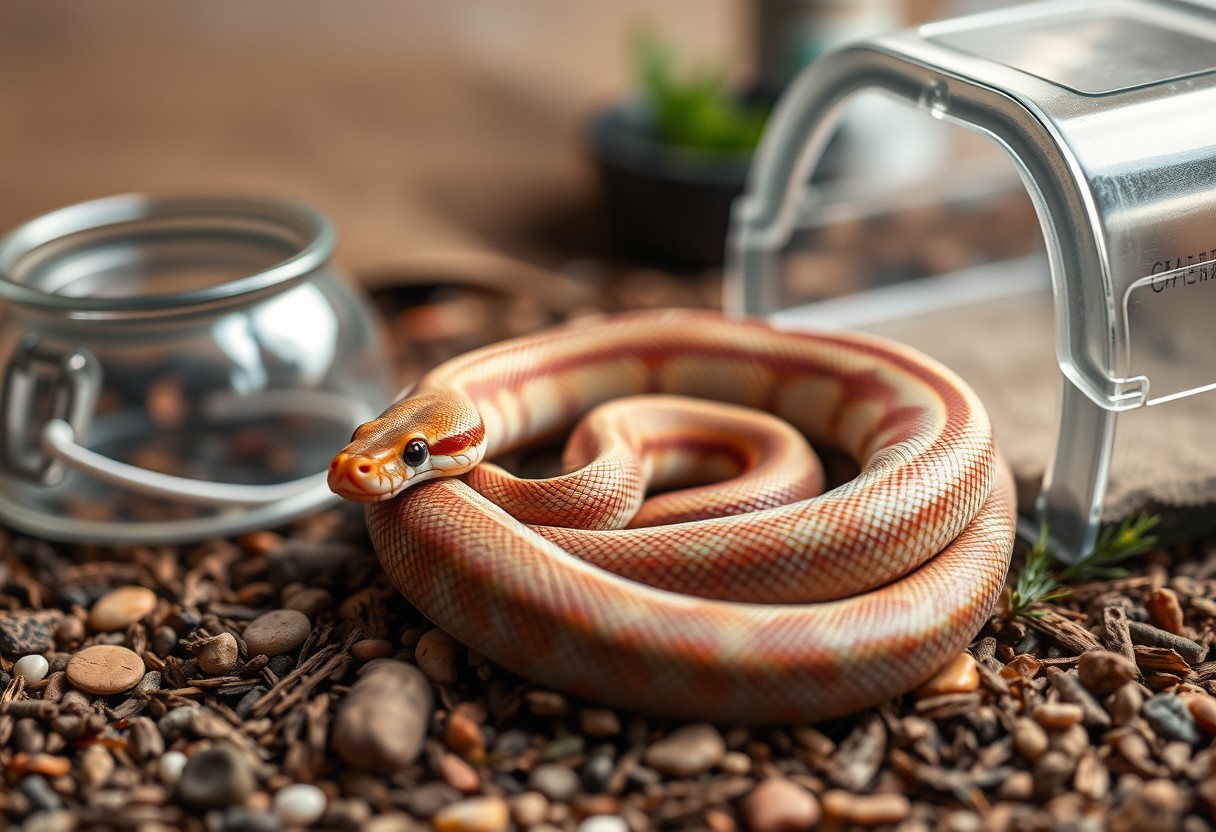
Handling and Interaction
Keep in mind that handling your scaleless corn snake can be a rewarding experience, fostering trust between you and your pet. Start with short sessions, gradually increasing the duration as your snake becomes more comfortable. To learn more about safe handling practices, check out this Complete Corn Snake Care Guide 2022. Always ensure you are calm and gentle to create a positive environment for interaction.
Proper Handling Techniques
Behind every successful handling session lies a strong understanding of your snake’s needs. Use both hands to support its body; this provides security and minimizes stress. Avoid grabbing your snake from above, as sudden movements can trigger defensive behaviors. Instead, gently approach from the side, allowing your corn snake to acclimate to your presence.
Understanding Snake Body Language
Snake body language gives you insight into your scaleless corn snake’s mood. Watch for subtle cues such as tail movement: a rapidly flicking tail may indicate agitation, while a slow, relaxed tail suggests comfort. Know when to give them space; if your snake is coiling tightly or hissing, it may be feeling threatened. By paying attention to these signals, you can create a better bonding experience while ensuring your snake feels secure and respected.
And observing your scaleless corn snake’s body language can dramatically improve your interactions. Look closely at their posture: a relaxed snake with a straight body is usually calm, while one that raises its head might be curious or defensive. Understanding these signals can help you gauge their comfort. Moreover, quick, erratic movements may indicate stress, so proceed cautiously if you notice such behavior. A well-connected bond can develop as you fine-tune your handling by being attentive to your snake’s emotions.
To wrap up
With these considerations in mind, you can effectively care for your scaleless corn snake and enhance its health and well-being. Ensure you provide appropriate habitat conditions, a balanced diet, and regular vet check-ups to catch any potential issues early. By remaining attentive to your snake’s specific needs, including humidity and temperature, you’ll create a thriving environment that promotes a long and happy life for your pet. Embrace your role as a responsible owner, and your scaleless corn snake will surely flourish under your care.
Q: What are the ideal housing conditions for a Scaleless Corn Snake?
A: Scaleless Corn Snakes thrive in an environment that mimics their natural habitat. Provide a terrarium that is at least 20 gallons for an adult snake, with a secure lid to prevent escapes. The temperature gradient should range from 75°F on the cool side to 85°F on the warm side, with a basking spot reaching up to 90°F. Use a substrate that retains humidity well, such as aspen shavings or coconut fiber, and include hiding spots, climbing branches, and a shallow water dish for hydration.
Q: What specific dietary needs do Scaleless Corn Snakes have?
A: Scaleless Corn Snakes are carnivorous and primarily feed on rodents. It’s necessary to provide a diet based on the snake’s size and age. Hatchlings can be fed pinky mice, while adults may consume larger prey like adult mice or small rats. Always feed pre-killed prey to prevent injuries. Additionally, maintaining a feeding schedule—every 5 to 7 days for juveniles and every 10 to 14 days for adults—is important for their metabolic health.
Q: How can I ensure proper humidity levels for my Scaleless Corn Snake?
A: Maintaining appropriate humidity is vital for the health of your Scaleless Corn Snake. Aim for humidity levels between 40% and 60%. You can achieve this by misting the enclosure regularly, placing a water bowl large enough for soaking, or incorporating live plants that help retain moisture. Use a hygrometer to monitor humidity levels accurately, and provide a humidity hide— a damp hide box— during shedding periods to assist in their skin sloughing process.


